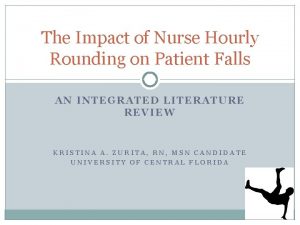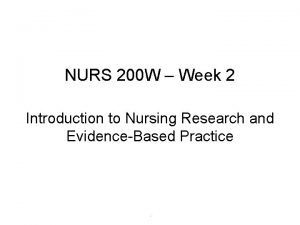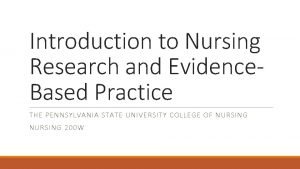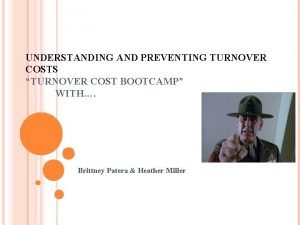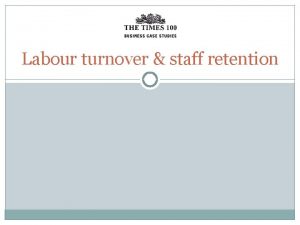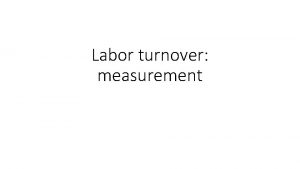450 PRESENTATION NURSING TURNOVER Introduction PICO question Would














- Slides: 14

450 PRESENTATION NURSING TURNOVER

Introduction � PICO question: Would adjusting staffing ratios and responsibilities on busy hospital floors increase employee satisfaction and decrease nurse turnover? � Study type: meta-analysis � Results: nurses’ satisfaction levels are highly related to their roles and ratios Satisfaction is the biggest reason for remaining in one’s current position

Method � Databases Used: Pub. Med and CINAHL � Search Terms Used: Nurse Job Satisfaction, Turnover, Workload, Retention, Patient Nurse Ratios � Results: I found many articles relating multiple factors to reasons nurse turnover is so high. I chose two of the articles that relate job satisfaction to nurse turnover.

References � Wen-Hsien, H. , Ying-Ling, S. , & Rong-Da, L. (2009). Effects of job rotation and role stress among nurses on job satisfaction and organizational commitment. BMC Health Services Research, 9(8). � Lynn, M. , & Redman, R. (2006). Staff nurses and their solutions to the nursing shortage. Western Journal Of Nursing Research, 28(6), 678 -693.

Reasoning � Wen-Hsien et al. shows the statistical proof that job satisfaction is a key to organizational commitment. They also explain that role stresses have huge impacts on satisfaction and therefore nurse retention. � Lynn et al. asks current nurses about their ideas to improve the nurse shortage. They relate that to job satisfaction.

Article 1 � Theory: Role stress has large impacts on satisfaction and thus on turnover rates � Type: Quantitative � Method & Design: 650 Questionnaires to nurses with job rotation experience (81. 8% participated). The study used SPSS 11. 0 and LISREL 8. 54 (Linear Structural Relationship Model) for statistical analysis. � Findings: High role stress= lower satisfaction Lower satisfaction = lower retention rates

Article 2 � Theory: Nurses should have input to stop the shortage rather than just the organizational level � Type: Qualitative � Method & Design: Descriptive design Random sample drawn Survey filled out by RN’s from diverse pool Used the Satisfaction In Nursing Scale (SINS) to show job satisfaction � Findings: 72. 9 percent of nurses who responded with multiple ideas chose “mandate specific maximum nurse-to-patient ratios”

Ethical Considerations � Article 1 Ethics committees at each facility approved Nurse supervisors posted surveys Nurses remained anonymous � Article 2 Nurses remained anonymous so answers did not affect relationships or jobs

Article 1 � Strength & Quality: Many validity standards- all acceptable values � Limitations: Questionnaires have limited value Studied only correlation between nurses’ perceptions, not the factors that caused them � Credibility: Peer-reviewed article All the authors have proper medical and academic credentials fitting the topic

Article 2 � � � Strength & Quality: published in a highly regarded journal expert peer reviewed Limitation: Questionnaire format : list bias potential Budget- small sample size Both studies are well-designed correlation studies, but lack the proper designs to be used as 100 percent reliable truth ◦ Both contribute to EBP, but all the authors agree that further studies are necessary to eliminate limitations

Relevance to Nursing � Communication Level: Professional level- Both articles outcomes communicated & carried out by the organizational leadership � Implications: Limited generalizability due to the designs Influence on further studies Potential future policies (pending further research) Training and mentoring policy changes Staffing ratio policy changes

Potential Barriers � Attitudes: Organizational Leadership willingness Nurses willingness to change and adjust � Costs: Large enough studies Length of time for the studies Cost analysis for staffing ratios sufficient to increase job satisfaction enough to affect turnover rates Upfront costs of implementing new mentoring programs

Extra Possible PICO Variables � P: � I: similar studies on hospital leadership other interventions to increase satisfaction � C: compare satisfaction and turnover among different hospitals or different careers � O: The desired outcome for most of the studies would be increased satisfaction and increased company loyalty

Conclusion � Problem of turnover rate among nurses � Importance � Potential � Further of job satisfaction among nurses ways to increase satisfaction studies necessary
 Penyiku dari perbandingan trigonometri sin 30° adalah
Penyiku dari perbandingan trigonometri sin 30° adalah Pico question nursing shortage
Pico question nursing shortage Powerpoint presentation on employee turnover
Powerpoint presentation on employee turnover Verb after would rather
Verb after would rather I would rather
I would rather Level 2 questions
Level 2 questions Hourly rounding and patient falls
Hourly rounding and patient falls Pico format question
Pico format question Pico question examples rehabilitation
Pico question examples rehabilitation Pico question myocardial infarction
Pico question myocardial infarction What is a good pico question
What is a good pico question Pico question examples hypertension
Pico question examples hypertension Iowa ebp model
Iowa ebp model Randi sokol
Randi sokol Pico questions
Pico questions






